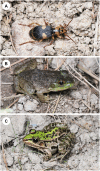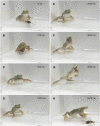Bombardier beetles repel invasive bullfrogs
- PMID: 36128194
- PMCID: PMC9482772
- DOI: 10.7717/peerj.13805
Bombardier beetles repel invasive bullfrogs
Abstract
Invasive non-native predators negatively affect native species; however, some native species can survive the predation pressures of invasive species by using pre-existing antipredator strategies or evolving defenses against invasive predators. The American bullfrog Lithobates catesbeianus (Anura: Ranidae) has been intentionally introduced to many countries and regions, and has impacted native animals through direct predation. Bombardier beetles (Coleoptera: Carabidae: Brachininae: Brachinini) discharge chemicals at a temperature of approximately 100 °C from the tip of the abdomen when they are attacked by predators. This "bombing" can successfully repel predators. However, adults of a native bombardier beetle Pheropsophus (Stenaptinus) occipitalis jessoensis have been reportedly found in the gut contents of the introduced bullfrog L. catesbeianus in Japan. These records suggest that the invasive bullfrog L. catesbeianus attacks the native bombardier beetle P. occipitalis jessoensis under field conditions in Japan; however, the effectiveness of the bombing defense against invasive bullfrogs is unclear. To test the effectiveness of the bombing defense against bullfrogs, we investigated the behavioral responses of L. catesbeianus juveniles to P. occipitalis jessoensis adults under laboratory conditions. Contrary to previous gut content results, almost all the bullfrogs (96.3%) rejected bombardier beetles before swallowing them; 88.9% rejected the beetles after being bombed, and 7.4% stopped attacking the beetles before being bombed. Only 3.7% successfully swallowed and digested the beetle. All of the beetles collected from non-bullfrog-invaded sites could deter bullfrogs, suggesting that the pre-existing defenses of bombardier beetles played an essential role in repelling bullfrogs. When treated beetles that were unable to discharge hot chemicals were provided, 77.8% of bullfrogs successfully swallowed and digested the treated beetles. These results indicate that bombing is important for the successful defense of P. occipitalis jessoensis against invasive bullfrogs. Although invasive bullfrogs have reportedly impacted native insect species, P. occipitalis jessoensis has an existing defense mechanism strong enough to repel the invasive predators.
Keywords: Bombardier beetles; Brachinini; Carabidae; Chemical defences; Introduced predators; Invasive alien species.
© 2022 Sugiura and Date.
Conflict of interest statement
The authors declare that they have no competing interests.
Figures



References
-
- Adriaens T, Devisscher S, Louette G. Risk analysis report of non-native organisms in Belgium: risk analysis of American bullfrog Lithobates catesbeianus (Shaw) Brussel: Instituut voor Natuur- en Bosonderzoek; 2013.
-
- Balfour PS, Morey SR. Prey selection by juvenile bullfrogs in a constructed vernal pool complex. Transactions of the Western Section of the Wildlife Society. 1999;35:34–40.
-
- Barrasso DA, Cajade R, Nenda S, Baloriani G, Herrera R. Introduction of the American bullfrog Lithobates catesbeianus (Anura: Ranidae) in natural and modified environments: an increasing conservation problem in Argentina. South American Journal of Herpetology. 2009;4(1):69–75. doi: 10.2994/057.004.0109. - DOI
Publication types
MeSH terms
Associated data
LinkOut - more resources
Full Text Sources

